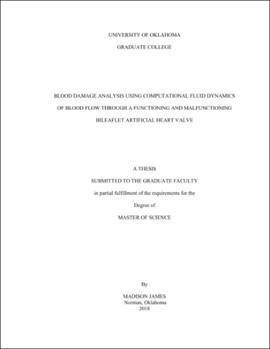| dc.description.abstract | Artificial heart valves are an invaluable tool to treat heart defects and diseases. However, these prosthetic devices may expose the blood to turbulent flow conditions leading to unnaturally high stress that can damage blood cells.
The purpose of this research is to simulate blood flow in both a functioning and malfunctioning bi-leaflet artificial heart valve and predict the damage caused to red blood cells (RBCs), specifically hemolysis, from the magnitude of the stress and exposure time as determined by analysis of the turbulent flow eddies. Using the computational fluid dynamics (CFD) software ANSYS DesignModeler, two prosthetic heart valve models were constructed: one with both leaflets open and functioning and one with one leaflet mostly closed. Blood flow simulations were done using ANSYS Fluent and validated with experimental findings available in the literature. Results from the CFD simulations provided the spatial distribution of Kolmogorov length scales (KLS) that were used to find the spatial and size distributions of eddies in the flow field. This CFD-based research utilized the number and surface area of eddies in the blood as a way to predict the amount of hemolysis experienced by RBCs. The analysis is centered on the hypothesis that only some of the turbulent flow eddies – those with sizes comparable to or smaller than the size of RBCs – are the ones that contribute to cell damage.
Results indicated that hemolysis levels are low, suggesting the need for further study of subhemolytic damage. The hemolysis predictions did allow for a comparative analysis of the heart valve simulations, which showed that more damage is expected at a higher flowrate, and that at the same flowrate, more damage is expected in the malfunctioning valve when compared to the functioning valve. | en_US |
